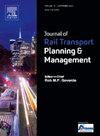在规定的中间时间间隔内,有能量消耗界限的水平轨道列车的最优驾驶策略
IF 2.7
Q3 TRANSPORTATION
Journal of Rail Transport Planning & Management
Pub Date : 2025-09-28
DOI:10.1016/j.jrtpm.2025.100550
引用次数: 0
摘要
为了管理电力的传输和分配,现在系统运营商提供财政激励,鼓励大用户在指定的高峰需求期间减少能源使用,这是一种普遍做法。对于大型铁路网络的列车运营商来说,减少高峰时段的能源使用,增加其他时间的能源使用,而不是简单地减少总体能源消耗,这可能是有利可图的。如果提高总体最佳驾驶速度,但通常的速度保持段被指定间隔上较低的最佳驾驶速度的海岸-速度保持-最大加速度段打断,则通常可以实现在某些中间时间间隔上所需的能源使用减少。Howlett等人(2023)的研究表明,当且仅当海岸阶段开始于进入指定间隔时间,加速阶段开始于退出时间时,这种类型的中断是最优的。本文证明了上述策略是次优策略,真正的最优限制策略是通常的速度保持阶段被最大加速度-海岸-速度保持-海岸-最大加速度段打断。此段的初始阶段在进入指定间隔时间时结束,最终阶段在退出时间开始。我们还将扩展新策略,以寻找具有多个预定中间时间间隔的能量消耗约束问题的最优限制策略。本文章由计算机程序翻译,如有差异,请以英文原文为准。
Optimal driving strategies for trains on level track with bounds on energy consumption during specified intermediate time intervals
In order to manage electricity transmission and distribution it is now common practice for system operators to offer financial incentives that encourage large consumers to reduce energy usage during designated peak demand periods. For train operators on large rail networks it may be profitable—with selected individual journeys—to reduce energy usage during peak times and increase energy usage at other times rather than simply minimizing overall energy consumption. The desired reduction in energy usage on some intermediate time interval can often be achieved if the overall optimal driving speed is increased but the usual speedhold segment is interrupted by a segment of coast–speedhold–maximum acceleration with a lower optimal driving speed on the designated interval. In Howlett et al. (2023) it was shown that an interruption of this type is optimal if and only if the coast phase begins at the entry time to the designated interval and the acceleration phase begins at the exit time. In this paper we show that the above strategy is a suboptimal strategy and that the true optimal restricted strategy is one where the usual speedhold phase is interrupted by a segment of maximum acceleration–coast–speedhold–coast–maximum acceleration. The initial phase for this segment ends at the entry time to the designated interval and the final phase begins at the exit time. We will also extend the new strategy to find optimal restricted strategies for problems with energy consumption constraints on multiple predetermined intermediate time intervals.
求助全文
通过发布文献求助,成功后即可免费获取论文全文。
去求助
来源期刊

Journal of Rail Transport Planning & Management
TRANSPORTATION-
CiteScore
7.10
自引率
8.10%
发文量
41
 求助内容:
求助内容: 应助结果提醒方式:
应助结果提醒方式:


